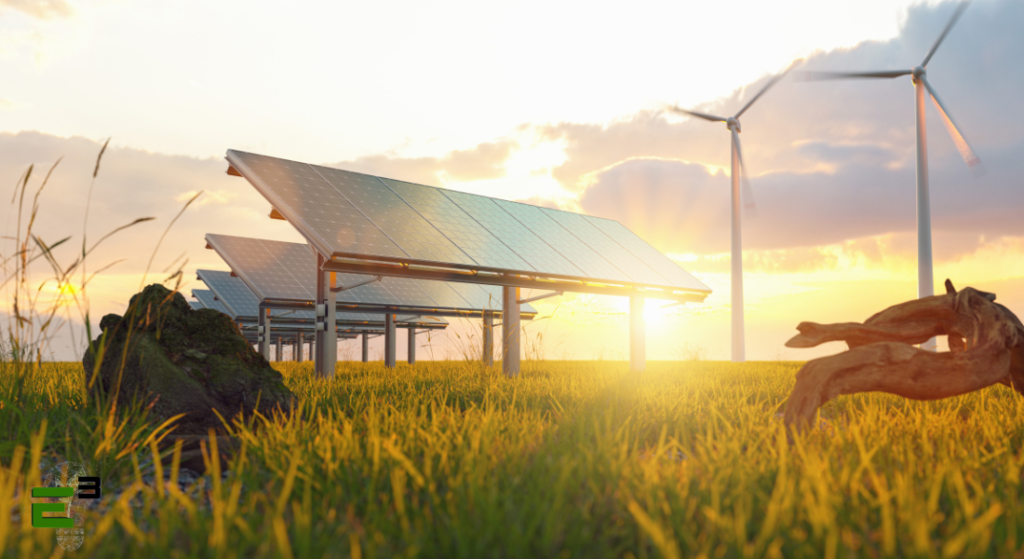Renewable energies are inexhaustible sources harnessed from natural elements such as sunlight, wind, water, biomass, and Earth’s internal heat. These sustainable energy forms include solar, wind, hydroelectric, biomass, and geothermal, contributing to a cleaner energy matrix, reducing carbon emissions, and fostering independence from fossil fuels.

Different types of Renewable Energies
Solar Energy
Solar energy is a form of renewable energy obtained through the capture of sunlight and its conversion into electricity using photovoltaic solar panels. These panels contain photovoltaic cells that convert solar light into electrical current, providing a clean and sustainable source of energy. The benefits of solar energy are diverse. Firstly, it is an inexhaustible source as the sun emits enormous amounts of energy daily. Additionally, its production does not emit atmospheric pollutants, contributing to the reduction of carbon emissions and mitigation of climate change. The installation of solar systems can also result in long-term cost savings, reducing electricity bills and providing energy independence. Solar energy plays a crucial role in transitioning to a more sustainable and environmentally conscious energy matrix.
Wind Energy
Wind energy is a vital form of renewable energy derived from the movement of the wind, captured by wind turbines to produce electricity, with a growing focus on enhancing the energy efficiency of this process. As the turbine blades convert kinetic energy into electricity, the pursuit of energy efficiency stands out as essential in sustainable development. This method not only provides a clean source of electricity, free from greenhouse gas emissions but also promotes the diversification of the energy matrix, reducing dependence on fossil fuels. Wind energy, coupled with an emphasis on energy efficiency, plays a crucial role in transitioning to a more sustainable and resilient energy system, shaping an environmentally conscious future.
Hydropower
Hydropower is a crucial source of renewable energy derived from the movement of water in rivers or dams. This form of electricity generation involves converting the potential energy of water into electricity through turbines. In addition to being a clean source, hydropower stands out for its energy efficiency, effectively harnessing the mechanical energy of moving water. The construction of dams also contributes to regulating river flow, flood control, and supplying water for multiple uses. The ongoing emphasis on energy efficiency in hydropower plants is crucial to optimize electricity production and minimize environmental impact. Hydropower plays a vital role in the global energy matrix, providing a sustainable and efficient source to meet growing energy demands.
Biomass Energy
Biomass energy is derived from organic materials like agricultural residues, wood, and biodegradable waste, harnessing their stored energy through combustion or biological processes. The utilization of biomass offers a renewable and carbon-neutral energy source, reducing greenhouse gas emissions. The energy efficiency of biomass systems involves optimizing the conversion process to minimize waste and maximize power generation. By converting organic materials into bioenergy, we not only address waste management but also contribute to a sustainable energy mix.
Geothermal Energy
Geothermal energy harnesses the Earth’s internal heat for power generation. This renewable source is derived from the Earth’s core, providing a constant and reliable energy supply. The energy efficiency of geothermal systems is notable, as they produce minimal emissions and offer a consistent power output. Utilizing natural heat from the Earth’s crust, geothermal energy exemplifies sustainable and low-impact energy production. By emphasizing energy efficiency in geothermal technologies, we can optimize the extraction process, ensuring a continuous and eco-friendly energy supply for the future.
Tidal Energy
Tidal energy is generated by harnessing the kinetic energy produced by the rise and fall of tides. This renewable energy source, dependent on the gravitational pull of the moon and the sun, provides a predictable and constant power supply. The energy efficiency of tidal systems lies in their ability to capture and convert the rhythmic motion of tides into electricity, offering a reliable and eco-friendly energy solution. Tidal energy contributes to a more sustainable energy matrix, reducing dependence on fossil fuels and minimizing environmental impact.
Wave Energy
Wave energy captures the power generated by the movement of ocean waves, converting it into electricity. This renewable energy source utilizes the constant motion of waves to produce a consistent power supply. The energy efficiency of wave systems involves optimizing the technology to efficiently capture and convert wave motion into electrical energy. By emphasizing energy efficiency in wave energy projects, we can enhance the sustainability of our energy sources, mitigating environmental impact and promoting a cleaner, more resilient energy future.
Renewable Energies and Energy Efficiency: A Symbiotic Path to a Sustainable Future
Renewable energies significantly contribute to energy efficiency by harnessing abundant, natural resources in a sustainable manner. Solar and wind technologies, for instance, continually improve their efficiency in capturing and converting energy. The inherent intermittent nature of some renewables, like solar and wind, drives innovation in energy storage technologies, ensuring a consistent power supply. Additionally, decentralized renewable systems enhance energy efficiency by reducing transmission losses associated with centralized power plants. Biomass and geothermal energy utilize organic matter and Earth’s internal heat efficiently, minimizing waste. Overall, the integration of renewable energies not only promotes a cleaner energy mix but also drives advancements in technology, enhancing overall energy efficiency and fostering a more sustainable and resilient energy landscape.
Renewable energies stand as the cornerstone of a sustainable and efficient energy future. Their ability to harness natural resources, coupled with ongoing advancements in technology, not only provides a cleaner alternative but also drives innovation in energy efficiency.
As we transition towards a greener energy landscape, the integration of renewables not only mitigates environmental impact but also fosters economic resilience and energy independence. Through this transformative journey, renewable energies exemplify a harmonious coexistence with energy efficiency, forming the bedrock of a cleaner, more efficient, and resilient energy paradigm for generations to come.



